 W
WA hand tool is any tool that is powered by hand rather than a motor. Categories of hand tools include wrenches, pliers, cutters, files, striking tools, struck or hammered tools, screwdrivers, vises, clamps, snips, saws, drills and knives.
 W
WAn air hammer, also known as an air chisel, is a pneumatic hand tool used to carve in stone, and to break or cut metal objects apart. It is designed to accept different tools depending on the required function.
 W
WAn automatic center punch is a hand tool used to produce a dimple in a workpiece. It performs the same function as an ordinary center punch but without the need for a hammer. When pressed against the workpiece, it stores energy in a spring, eventually releasing it as an impulse that drives the punch, producing the dimple. The impulse provided to the point of the punch is quite repeatable, allowing for uniform impressions to be made.
 W
WA backscratcher is a tool used for relieving an itch in an area that cannot easily be reached just by one's own hands, typically the back.
 W
WA block plane is a small metal-bodied woodworking hand plane which typically has the blade bedded at a lower angle than other planes, with the bevel up. It is designed to cut end grain and do touchup or finish work. It is typically small enough to be used with one hand.
 W
WA bullwhip is a single-tailed whip, usually made of braided leather, designed as a tool for working with livestock.
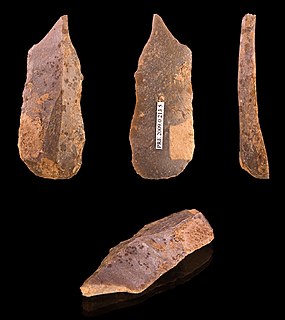 W
WIn the field of lithic reduction, a burin is a type of handheld lithic flake with a chisel-like edge which prehistoric humans used for engraving or for carving wood or bone.
 W
WA candle snuffer, candle extinguisher, or douter is an instrument used to extinguish burning candles, consisting of a small cone at the end of a handle. The use of a snuffer helps to avoid problems associated with blowing hot wax. Extinguishers are still commonly used in homes and churches.
 W
WA card scraper or cabinet scraper is a woodworking shaping and finishing tool. It is used to manually remove small amounts of material and excels in tricky grain areas where hand planes would cause tear out. Card scrapers are most suitable for working with hardwoods, and can be used instead of sandpaper. Scraping produces a cleaner surface than sanding; it does not clog the pores of the wood with dust, and does not leave a fuzz of torn fibers, as even the finest abrasives will do.
 W
WDadeumi or Dadeumijil or Kinuta is a Chinese, Korean, and Japanese traditional ironing method where two women knelt on the floor, facing each other across a smoothing stone or Dadeumitdol (다듬잇돌), beating out a rhythm on the cloth to press out the wrinkles of the laundered cloth and soften it. Dadeumi is a unique to Korea. Dadeumi requires Dadeumitbangmang-i and Dadeumitdol. Dadeumitbangmang-i is a bat that pounds on the cloth. The stone under the cloth is called a Dadeumitdol. Also, the cloth is wrapped in a thick round bat, Hongdooggae ', and Dadeumi is performed. It is used to trim a thin cloth such as ramie fabric or silk.
 W
WThe dolabra is a versatile axe used by the people of Italy since ancient times. The dolabra could serve as a pickaxe used by miners and excavators, a priest's implement for ritual religious slaughtering of animals and as an entrenching tool (mattock) used in Roman infantry tactics.
 W
WHacking or side knives may be considered as either light hatchets or heavyweight knives.
 W
WA hackle is a metal plate with rows of pointed needles used to blend or straighten hair.
 W
WA hacksaw is a fine-toothed saw, originally and mainly made for cutting metal. The equivalent saw for cutting wood is usually called bow saw.
 W
WA Halligan bar, also known as a Halligan tool, is a forcible entry tool used by firefighters and law enforcement.
 W
WA handheld fan, or simply hand fan, may be any broad, flat surface that is waved back-and-forth to create an airflow. Generally, purpose-made handheld fans are folding fans, which are shaped like a sector of a circle and made of a thin material mounted on slats which revolve around a pivot so that it can be closed when not in use.
 W
WIn woodworking and carpentry, hand saws, also known as "panel saws", are used to cut pieces of wood into different shapes. This is usually done in order to join the pieces together and carve a wooden object. They usually operate by having a series of sharp points of some substance that is harder than the wood being cut. The hand saw is a bit like a tenon saw, but with one flat, sharp edge.
 W
WA hand truck, also known as a two wheeler, stack truck, trundler, box cart, sack barrow, cart, dolly, sack truck, or bag barrow, is an L-shaped box-moving handcart with handles at one end, wheels at the base, with a small ledge to set objects on, flat against the floor when the hand-truck is upright. The objects to be moved are tilted forward, the ledge is inserted underneath them, and the objects allowed to tilt back and rest on the ledge. The truck and objects are then tilted backward until the weight is balanced over the wheels, making otherwise bulky and heavy objects easier to move. It is a first-class lever.
 W
WA handspike is a metal bar or pipe that is used as a lever for prying or leverage, similar to a crowbar. Handspike is also an archaic term for a bar or lever, generally of wood, used in a windlass or capstan, for heaving anchor, and, in modified forms, for various other purposes.
 W
WA hawk is a tool used to hold a plaster, mortar, or a similar material, so that the user can repeatedly, quickly and easily get some of that material on the tool which then applies it to a surface. A hawk consists of a board about 13 inches square with a perpendicular handle fixed centrally on the reverse. The user holds the hawk horizontally with the non-dominant hand and applies the material on the hawk with a tool held in the dominant hand.
 W
WA hook is a hand tool used for securing and moving loads. It consists of a round wooden handle with a strong metal hook about 8" long projecting at a right angle from the center of the handle. The appliance is held in a closed fist with the hook projecting between two fingers.
 W
WAn ice scraper is a handheld tool for removing frost, ice, and snow from windows, usually on automobiles. Basic scrapers have a plastic blade and handle, though some have blades made out of metal. More complex models often include brushes to help remove collected snow, or squeegees to remove water if the ambient temperature is near the melting point. Alternatively, the handle can be inside a glove-like enclosure to help keep the user's hands warm and dry when using the scraper.
 W
WA measuring rod is a tool used to physically measure lengths and survey areas of various sizes. Most measuring rods are round or square sectioned; however, they can also be flat boards. Some have markings at regular intervals. It is likely that the measuring rod was used before the line, chain or steel tapes used in modern measurement.
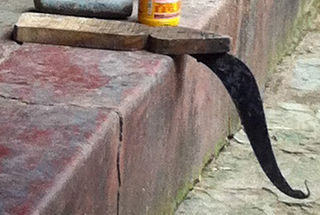 W
WPaniki is a traditional East Indian tool with a cutting edge with a wooden footrest. Panikis are used in the kitchen for chopping vegetables, fish and meat. Panikis are mostly found in Odisha, India and the variations of the tool is known as Boti in West Bengal and Tripura in India and in Bangladesh. Various tribes of Odisha used for different purposes. The tribe members of the Mutkia Kondha worship paniki as deity and do not keep their feet with their feet. They rather use a special type of paniki with a wooden stand. Panikis of ancient times show engraving of cultural and religious elements. Traditionally in rural Odisha, panikis are made from cast iron by the blacksmith.
 W
WA pickaxe, pick-axe, or pick is a generally T-shaped hand tool used for prying. Its head is typically metal, attached perpendicularly to a longer handle, traditionally made of wood, occasionally metal, and increasingly fiberglass.
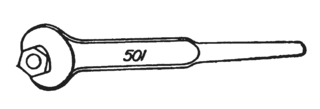 W
WA podger spanner, or podger is a tool in the form of a short bar, usually tapered and often incorporating a wrench at one end.
 W
WA punch is a hard metal rod with a narrow tip at one end and a broad flat "butt" at the other. When used, the narrower end is pointed against a target surface and the broad end is then struck with a hammer or mallet, causing the blunt force of the blow to be transmitted down the rod body and focused more sharply onto a small area. Typically, woodworkers use a ball-peen hammer to strike a punch.
 W
WA set square or triangle is an object used in engineering and technical drawing, with the aim of providing a straightedge at a right angle or other particular planar angle to a baseline.
 W
WA shove knife is a forcible entry tool used mainly by firefighters. Generally, they consist of a small, semi-rigid piece of 10 gauge steel with an indented end. The device is inserted between a door and the door frame, above the spring latch on outwardly-swinging doors equipped with key-in-the-knob locks. The tool is pulled down and outward, releasing the locking mechanism.
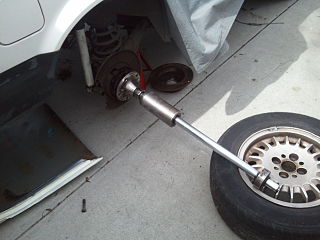 W
WA slide hammer is a tool that attaches to an object needing to be pulled and transmits an impact force to the object without striking the object itself.
 W
WThe Stanley No.1 Odd Jobs was a tool produced by the Stanley Works from 1888 to the 1930s. It combined features of sundry tools, in a single pocketable tool, including:Try square Mitre square T-square Marking gauge Mortise gauge Depth gauge Mitre level Spirit level and plumb Beam compass Inside square Ruler
 W
WDrafting tools may be used for measurement and layout of drawings, or to improve the consistency and speed of creation of standard drawing elements. Tools such as pens and pencils mark the drawing medium. Other tools such as straight edges, assist the operator in drawing straight lines. Various scales and the protractor are used to measure the lengths of lines and angles, allowing accurate scale drawing to be carried out! The compass is used to draw arcs and circles. A drawing board was used to hold the drawing media in place; later boards included drafting machines that sped the layout of straight lines and angles. Tools such as templates and lettering guides assisted in the drawing of repetitive elements such as circles, ellipses, schematic symbols and text. Other auxiliary tools were used for special drawing purposes or for functions related to the preparation and revision of drawings. The tools used for manual technical drawing have been displaced by the advent of computer-aided drawing, draughting and design (CADD).
 W
WAn upholstery hammer is a lightweight hammer used for securing upholstery fabric to furniture frames using tacks or small nails.
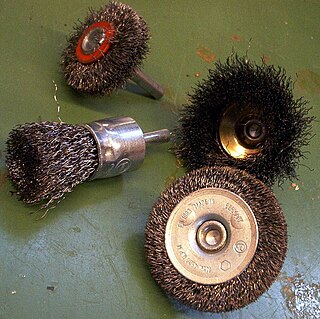 W
WA wire brush is a tool consisting of a brush whose bristles are made of wire, most often steel wire. The steel used is generally a medium- to high-carbon variety and very hard and springy. Other wire brushes feature bristles made from brass or stainless steel, depending on application. Wires in a wire brush can be held together by epoxy, staples, or other binding. Wire brushes usually either have a handle of wood or plastic or are formed into a wheel for use on angle grinders, bench grinders, pistol-grip drill motors, or other power tools.